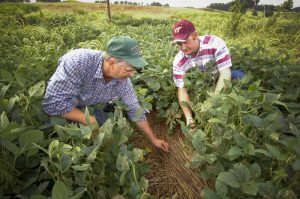2018 Farm Bill has increased funding for voluntary conservation programs meant to address environmental issues
The new Farm Bill tripled the amount that goes to the Regional Conservation Partnership Program to $300 million. The partnership helps farmers in areas like the Great Lakes who want to improve their soil and prevent nutrients from running off their land and polluting waterways.
“This boost of investment is a real win, not just for farmers but for the Great Lakes and water quality,” says Jordan Lubetkin, the communications director for the environmental group, the Healing Our Waters-Great Lakes Coalition.
Matt Doss, the policy director of the regional Great Lakes Commission, states “the Great Lakes are going to be in a better position for securing funding for priority watersheds within the Great Lakes where we know that agricultural operations are having a negative impact on water quality and habitat.”
Currently in Lake Erie, agriculture is one of the primary sources of nutrients that is causing toxic algae. The new farm bill could mean that Ohio farmers will receive more financial assistance to implement voluntary programs such as cover crops, that would help prevent nutrient runoff into the Great Lakes. Past Ohio projects have focused on water quality monitoring and increasing farmer access to technical assistance.

Farmers in a Rockingham County, Virginia check the results of no-till farming in their fields on September 9, 2008, as part of their participation in the U.S. Department of Agriculture (USDA) Natural Resource Conservation Service (NRCS) Chesapeake Bay Watershed Initiative (CBWI). CBWI is voluntarily program that farmers, ranchers and forestland owners install conservation practices on hundreds of thousands of acres annually to help support rural economies, protect wildlife habitat and improve water quality in the Chesapeake Bay Watershed. No-till farming is a way of growing crops from year to year without disturbing the soil through tillage. No-till is an agricultural technique, which increases the amount of water and organic matter (nutrients) in the soil and decreases erosion. USDA photo by Bob Nichols.
Some of the benefits of planting cover crops are listed below:
-Cover crops have been shown to increase crop yields, breakthrough a plow pan, add organic matter to the soil, improve crop diversity on farms and attract pollinators. There is an increasing body of evidence that growing cover crops increase resilience in the face of erratic and increasingly intensive rainfall, as well as under drought conditions. Cover crops help when it doesn’t rain, they help when it rains, and they help when it pours.
-The protective canopy formed by a cover crop reduces the impact of raindrops on the soil surface thereby decreasing the breakdown of soils aggregates. This greatly reduces soil erosion and runoff, and increases infiltration. Decreased soil loss and runoff translates to reduced transport of valuable nutrients, pesticides, herbicides, and harmful pathogens associated with manure from farmland that degrade the quality of streams, rivers and water bodies and pose a threat to human health.
-A cover crop slows the velocity of runoff from rainfall and snowmelt, reducing soil loss due to sheet and rill erosion.
-Over time, a cover crop regimen will increase soil organic matter, leading to improvements in soil structure, stability, and increased moisture and nutrient holding capacity for plant growth. These properties will reduce runoff through improved infiltration (movement of water through the soil surface) and percolation (movement of water through the soil profile).
Doss says that the work is not over and we will need to continually assess the effectiveness of these government programs. He claims, “we need to continue to look at how we can best implement these programs, make them most targeted to the areas that most need conservation treatment, and also that we’re collecting information and able to assess the effectiveness of these and any government program.”
The conservation programs supported by the Farm Bill allow farmers to do what they want to do-be good stewards of the land and ultimately, our water and air.
To learn more about these conservation programs and how they will benefit people and the environment, click here.
Article adapted from original articles by Indiana Public Media and Idea Stream.
